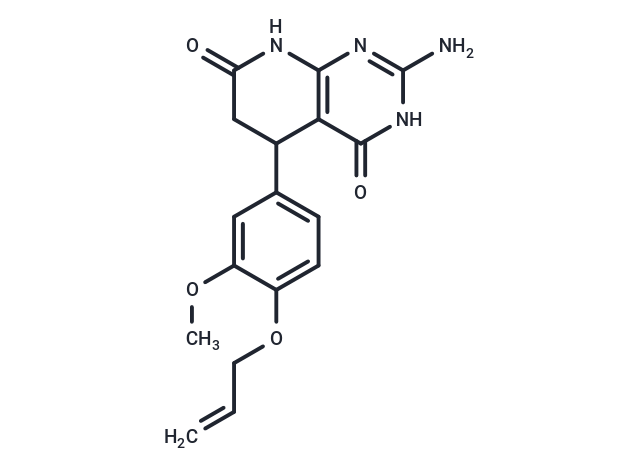Shopping Cart
Remove All Your shopping cart is currently empty
Your shopping cart is currently empty
PA-8 is a small molecule receptor antagonist for PACAP Type I (PAC1) that is selective, effective, and orally active. PA-8 inhibits PacAP-induced CREB phosphorylation at PAC1- receptors, but does not inhibit VPAC1- or vpac2 receptors. PA-8 also inhibited PacAP-induced elevation of cAMP levels in vitro (IC50 = 2 nM) and PacAP-induced aversive response and mechanical atopic pain after intrathecal injection in vivo.

| Pack Size | Price | USA Warehouse | Global Warehouse | Quantity |
|---|---|---|---|---|
| 5 mg | $39 | In Stock | In Stock | |
| 10 mg | $72 | In Stock | In Stock | |
| 25 mg | $155 | In Stock | In Stock | |
| 50 mg | $272 | In Stock | In Stock | |
| 100 mg | $478 | In Stock | In Stock | |
| 1 mL x 10 mM (in DMSO) | $43 | In Stock | In Stock |
| Description | PA-8 is a small molecule receptor antagonist for PACAP Type I (PAC1) that is selective, effective, and orally active. PA-8 inhibits PacAP-induced CREB phosphorylation at PAC1- receptors, but does not inhibit VPAC1- or vpac2 receptors. PA-8 also inhibited PacAP-induced elevation of cAMP levels in vitro (IC50 = 2 nM) and PacAP-induced aversive response and mechanical atopic pain after intrathecal injection in vivo. |
| Targets&IC50 | cAMP:2 nM |
| In vitro | In PAC1/CHO cells, PA-8 (10 pM to 10 nM; 30 minutes) dose-dependently inhibits PACAP (1 nM)-induced CREB phosphorylation. In VPAC1/CHO and VPAC2/CHO cells, PACAP (1 nM) also induces CREB phosphorylation; however, PA-8 (10 pM to 10 nM) does not inhibit this effect [1]. |
| In vivo | Treatment with PA-8 (100 pmol/5 μL; via intrathecal injection; single dose; in male ddY mice) effectively suppresses PACAP-induced aversive reactions and mechanical allodynia in vivo [1]. Additionally, oral administration of PA-8 (3-30 mg/kg) leads to a dose-dependent reduction in the second phase of formalin-induced pain responses. PA-8 also significantly reduces c-fos expression in the spinal cord's ipsilateral dorsal horn [2]. This showcases PA-8's potential in mitigating nociceptive behaviors and neuronal activation in a PACAP-administered male ddY mouse model (6 weeks old; 100 pmol PACAP) [1], confirming its analgesic and anti-allodynic effects in vivo. |
| Molecular Weight | 342.35 |
| Formula | C17H18N4O4 |
| Cas No. | 878437-15-1 |
| Smiles | COc1cc(ccc1OCC=C)C1CC(=O)Nc2nc(N)[nH]c(=O)c12 |
| Color | White |
| Appearance | Solid |
| Storage | Powder: -20°C for 3 years | In solvent: -80°C for 1 year | Shipping with blue ice/Shipping at ambient temperature. | ||||||||||||||||||||||||||||||
| Solubility Information | DMSO: 22.5 mg/mL (65.72 mM), Sonication and heating to 60℃ are recommended. | ||||||||||||||||||||||||||||||
| In Vivo Formulation | 10% DMSO+40% PEG300+5% Tween 80+45% Saline: 2 mg/mL (5.84 mM), Sonication is recommended. Please add the solvents sequentially, clarifying the solution as much as possible before adding the next one. Dissolve by heating and/or sonication if necessary. Working solution is recommended to be prepared and used immediately. The formulation provided above is for reference purposes only. In vivo formulations may vary and should be modified based on specific experimental conditions. | ||||||||||||||||||||||||||||||
Solution Preparation Table | |||||||||||||||||||||||||||||||
DMSO
| |||||||||||||||||||||||||||||||
| Size | Quantity | Unit Price | Amount | Operation |
|---|

Copyright © 2015-2025 TargetMol Chemicals Inc. All Rights Reserved.